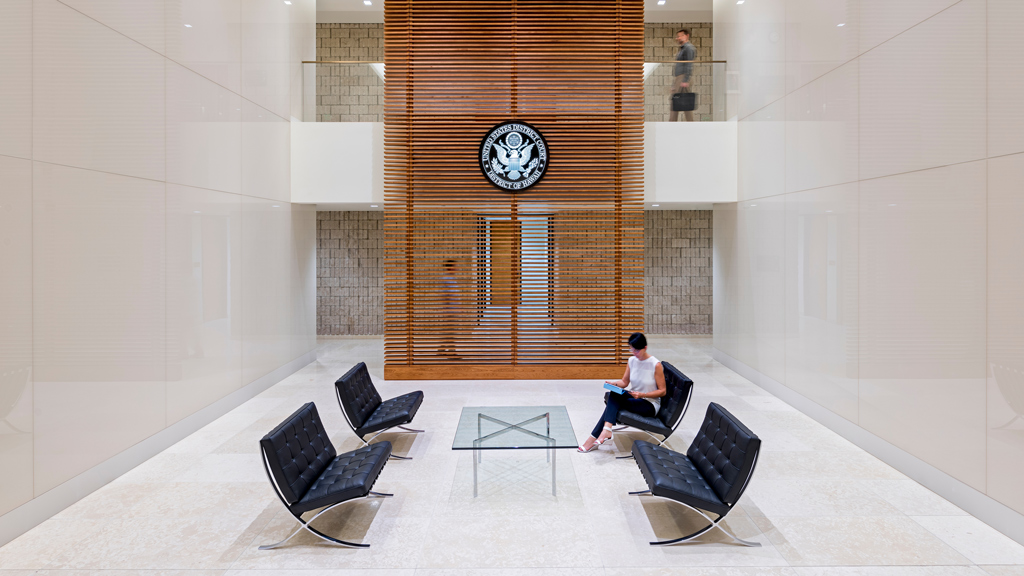Designing Government Offices for the Post-COVID Era
May 11, 2020 | By Robert A. Peck and Peter Barsuk
Editor’s Note: This post is part of our ongoing exploration of how design is responding to the COVID-19 pandemic.
For many amazing government workers, the coronavirus pandemic has not displaced them from their normal workplace. For first responders, it has meant a more urgent-but-similar experience working at field locations or on dispatch and in fire houses and hospitals in close proximity to others. For public health and other officials, it has meant coming into the workplace and distancing as best as possible.
But, for thousands of other government employees, it has meant working from home. As we prepare to return to the workplace, whenever that happens, what should public agencies and departments be doing to prepare a workplace that can help people feel healthy?
We’ve been giving this a lot of thought, and have been learning lessons from our colleagues in China. We’ve also been consulting with our colleagues who focus on health and wellness and workplace strategy and have been talking to building industry partners and clients.
Here are some takeaways for the immediate future, and the medium and long term, many of which are no cost/low cost operational solutions.
Immediate steps
1. Stagger people’s re-entryTo help maintain social distance by de-densifying the workplace, not everyone should return to work at once. Employees whose work requires more collaboration or involves direct interaction with the public should return first. Others can continue to telework. Older employees and those with underlying medical conditions should return last.
2. Consider alternating shiftsDivide returning employees into alternate day cohorts to maintain a lower population each day in the workplace. To reduce crowding in lobbies and elevators, assign staggered arrival times and lunch times.
3. De-densify desk seatingIn open environments and conference rooms, ensure that people are separated by the CDC-required six feet in all directions. If necessary, eliminate seating in every other seat position. This goes hand in hand with staggering shifts. In open offices, shield seat neighbors by providing a solid partition where none exists now. Continue to encourage virtual meetings.
4. Provide health screeningMost government buildings already have security in their entry lobbies. We should now provide passive temperature and/or rapid COVID screening to the extent that the equipment and testing is available. Employees and citizens showing a fever should be denied admittance and directed to receive medical attention.
5. Clean and sanitize more frequentlyThis should occur at least daily in common areas. Practice at least daily cleaning of frequently touched surfaces, including tables, doorknobs, light switches, handles, desks, toilets, faucets, sinks, etc. Provide an alcohol-based hand sanitizer or disinfecting wipes with at least 60% alcohol for use at employee workstations and pantries, as well as in visible, frequently used locations such as registration lobbies and adjacent to restroom and elevator doors and exits.
Mid-term steps
1. Upgrade air handling systemsSystems should increase the volume of exchange between indoor and outdoor air. Here’s a short primer on air filtration for building owners and developers.
2. Provide touchless officesInstall automatic door openers where possible. Convert buildings to include elevators that recognize employees’ floor destinations from their security card or fob. We go into more details about the touchless workplace in this blog post.
3. Conduct public meetings near the entrance.Citizen interactions and meetings should take place on the ground floor, as close to the entry as possible (following temperature scanning). If necessary, convert a ground-floor space to this purpose.
Long-term steps
1. Establish work from home policiesWe have learned that working from home (WFH) is effective for certain activities that can be performed alone (like auditing and report-writing), and for many collaborative work functions. Planning for office space should take this into account. Office policies need to be revised if they do not include WFH options. Check out these work-from-home considerations.
2. Discontinue seat sharingFor the foreseeable future, organizations will avoid assigning desks on a day-by-day basis. Few government offices have embraced “hot desking” up to now, so it should not widely impact space planning for the next several years.
3. Promote seat distancing as the normThe open office will not go away. It’s still a great tool for promoting collaborative problem-solving and giving everyone access to daylight and views. But minimum distances between employees will become standard. Maximum numbers of people in meeting rooms will be posted. Note that, combined with more people working from home, this may not require a significant increase in square footage per person overall.
4. Raise touchless to the next levelOver time, make touchless technologies more prevalent in the workplace. Office doors can be automated or completely eliminated. Restroom and elevator doors can sense a signal from an employee’s fob. Auto-operators with advanced sensing mechanisms will become more prevalent.
5. Isolate interactions with the publicIn many civic buildings, public-facing service functions, such as permitting and licensing, are already clustered in ground-floor areas. This is a good practice to continue. For both security and health reasons, employees should be able to meet guests outside of their own working areas. Service functions that cannot yet occur online will be shifted to digital platforms at a more rapid pace.
6. Incorporate virtual technologyPublic hearing rooms should be redesigned to accommodate virtual participation by hearing officials and citizens. Meetings will include a combination of face-to-face and remote participants. This is not only a health accommodation: it will permit more members of the public to take part in participatory democracy. As a result, hearing rooms will take on more aspects of a broadcast studio.
COVID-19 has already changed the way we work, requiring us to bring aspects of our workplace into our homes. As we go forward, the trend will be for smaller, better-thought-out office buildings. Simply put, the new normal is for our facilities’ design, maintenance, and operations to inspire a sense of health, safety, and trust in our government employees and the public they serve.
For media inquiries, email .


